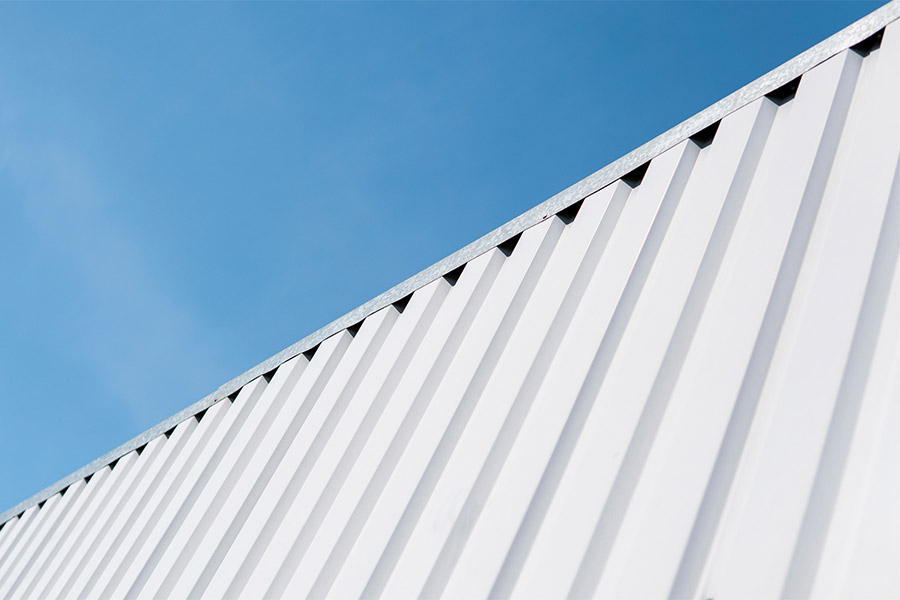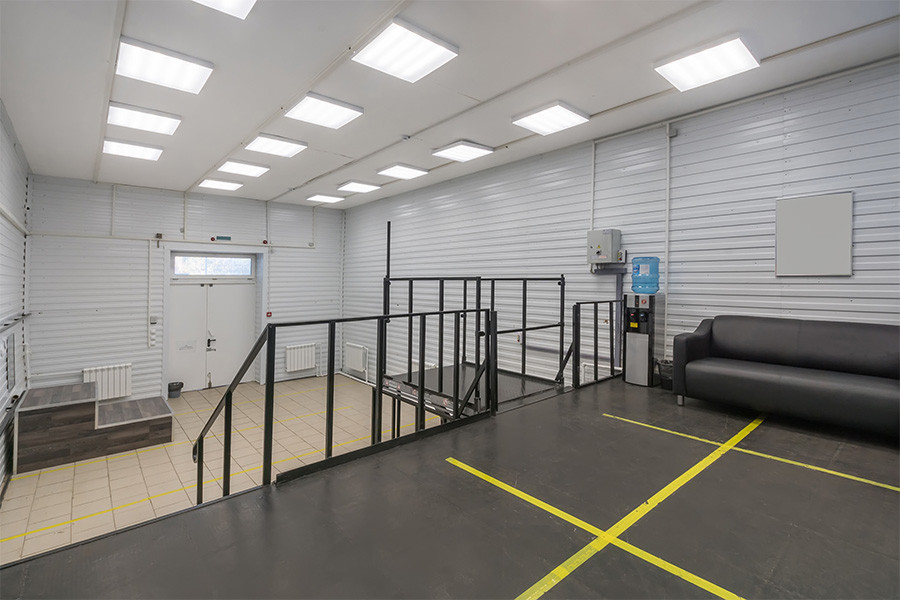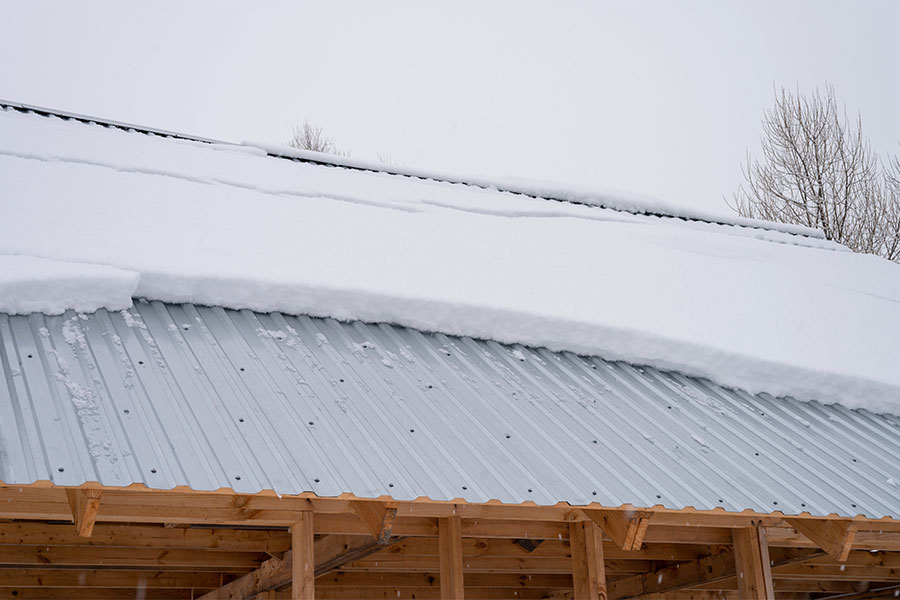Yes, they’re both types of metal panels that start with a “g”, have coatings that are applied to steel core products, and sort of sound similar. But galvalume and galvanized are very different types of products…and picking the wrong one could cause your roofing project to go sideways.
We’re going to cover the difference between galvalume vs galvanized steel so you can select the best metal materials for your next metal roofing or wall project.
What Is Galvalume? What Is Galvanized?
Galvalume and galvanized are both types of steel metal panels with protective coatings applied to a steel panel substrate. However, they use different metals for protection. Galvanized steel is coated in pure zinc (a layer of zinc metal) through a hot-dip process. The zinc coating acts like a sacrificial shield: it corrodes (oxidizes) in place of the steel, forming a protective zinc oxide layer that keeps the steel from rusting. In simpler terms, galvanized metal panels are like steel covered in a zinc armor. If the armor gets scratched, the zinc “sacrifices” itself to protect the exposed steel from rust.
Galvalume steel, on the other hand, is coated with a mixed alloy of aluminum and zinc (plus a touch of silicon) rather than just zinc. Roughly half of the coating is aluminum and half is zinc. This combination gives galvalume a two-for-one defense: the aluminum provides a tough, long-lasting barrier against rust, while the zinc still offers sacrificial protection for cut edges or scratches. You can think of galvalume as a steel panel dipped in a blended metal cocktail; it has aluminum for long-term corrosion resistance and zinc for added self-healing protection.
Galvalume was developed later (in the 1970s) as an improvement over traditional galvanizing, and it quickly became the industry standard for metal roofing panels due to its superior performance.
Aesthetics: Galvalume vs Galvanized
In appearance, unpainted galvanized and galvalume panels look a bit different. Galvanized metal panels often have a spangled, shiny silver finish (zinc naturally forms a bright spangle pattern). Galvalume panels tend to have a smoother, matte metallic look that’s a bit more toned-down in shine. However, both can be factory-painted in any color, so if your metal roofing panels will be painted, the visual difference isn’t noticeable. The main differences come down to performance and usage rather than looks.
The Key Differences Between Galvalume vs Galvanized
Despite both having zinc-based coatings on steel, galvalume and galvanized metal have key differences in their composition, longevity, and best use cases. Here’s a breakdown on the major differences you need to know.
Composition and Protection
Galvanized steel is coated only with zinc, while galvalume steel is coated with a zinc-aluminum alloy. This means galvanized relies purely on zinc’s sacrificial protection, whereas galvalume combines zinc’s protection with aluminum’s longer-term corrosion resistance. The result is that galvalume provides stronger overall corrosion resistance than galvanized in most environments.
Longevity
Thanks to that aluminum-zinc mix, galvalume panels typically last much longer before showing signs of rust. A galvalume metal roof might last up to 60+ years in a normal environment, whereas a galvanized metal roof might last on the order of 20-30 years before corrosion becomes an issue. Exact life spans vary with climate and panel thickness, but galvalume generally outlasts galvanized by decades.
Performance in Different Environments
Galvalume excels in many climates. It holds up well in rain, snow, and sun over the long term with minimal rust. Galvanized also protects well but is more prone to rust once its zinc layer is worn or scratched. Notably, in high-moisture or humid environments, galvanized roofs tend to require more maintenance and may rust earlier than galvalume. However, in certain harsh environments (like barns with livestock or heavy industrial use), galvanized steel can sometimes handle specific corrosive agents better than galvalume (more on that below).
“Self-Healing” vs. Ongoing Rust
If the panel is cut or scratched, galvalume has a self-healing property where any initial red rust at the exposed steel will slow down and stop, thanks to the protective action of its aluminum/zinc coating. With galvanized steel, when a scratch exposes the steel, the zinc will protect it for a while, but eventually that spot can develop red rust that continues to spread if not addressed.
Warranty and Industry Use
Because of its predictability and durability, galvalume steel often comes with long-term warranties (for example, many manufacturers offer a 20–25 year warranty against perforation on galvalume panels. Galvanized panels, on the other hand, usually do not carry substrate warranties, since their performance can be more unpredictable and shorter-lived.
Formability and Usage
Galvanized steel tends to be a bit more malleable than galvalume. It can bend or be stamped with slightly less risk of cracking. This means galvanized metal panels are sometimes preferred for highly formed products like stamped metal shingles or complex flashings, where a lot of bending is required. For typical standing seam or corrugated panels, though, galvalume performs just as well since those panels don’t require extreme bends.
Cost
Galvalume vs galvanized steel are usually similarly priced per square foot. Historically, galvanized was a bit cheaper, but in recent years, the prices have fluctuated and are often on par with each other. So cost isn’t a big advantage either way. The real difference is the long-term value: you generally get more lifespan for the same money with galvalume panels, which is why it’s often seen as the better long-term investment.
Even with this comparison laid out, there are specific scenarios where galvalume over galvanized or vice versus might be preferable over the other. Let’s dig into details.
When Galvalume Might Be the Better Choice
In most modern roofing and siding projects, galvalume offers superior long-term performance. Here’s when it makes the most sense:
- Residential Roofing in Most Climates: For inland homes, galvalume’s enhanced corrosion resistance helps metal roofing panels stay rust-free for decades. Many roofs last 50+ years with minimal maintenance, often backed by long perforation warranties for added peace of mind.
- Commercial and Architectural Projects: Galvalume steel is the industry standard for standing seam roofing, wall panels, and other architectural systems thanks to its durability, warranty coverage, and wide availability. Architects often specify it for high-end projects where longevity and low maintenance are priorities.
- Painted Metal Panels and Aesthetics: Galvalume is the go-to substrate for painted metal panels due to excellent paint adhesion and corrosion protection. Unpainted, its subtle matte sheen offers a modern look that some prefer over galvanized’s brighter spangle.
- Long-Term Value and Low Maintenance: Developed as an improvement over galvanized, galvalume can last two to four times longer in similar conditions. Its longevity means fewer repairs, less risk of rust, and a roof built to stand the test of time.
When Galvanized Makes More Sense
While galvalume is the norm, galvanized panels are better in certain cases:
- Agricultural Buildings & Livestock Facilities: Ammonia in animal waste reacts with aluminum in galvalume, causing faster corrosion. Galvanized’s zinc-only coating holds up better in barns, stables, and other livestock structures, especially with good ventilation.
- Coastal or Highly Corrosive Environments: Neither coating is ideal near saltwater, but galvanized can resist salt spray slightly better in the short term. For most coastal projects, aluminum or specialty coatings are the safer choice.
- Budget or Readily Available Solutions: In rural areas, galvanized panels are widely stocked and cost-effective for sheds, hay barns, or carports where a 20-year lifespan is acceptable. Their bright, traditional finish can also suit rustic designs.
- Highly Formed Roofing Products: Galvanized’s extra malleability makes it suitable for stamped shingles, curved trims, and intricate metalwork, where heavy bending might crack a galvalume coating.
Why This Matters for Montana Projects
Montana’s climate brings snowy winters, strong summer UV, and big temperature swings. Choosing the wrong substrate could mean rust or roof failure far sooner than expected.
For most homes and businesses, galvalume is ideal. It thrives in Montana’s inland, moisture-rich environment without the corrosion risks galvanized faces over time. A galvalume roof can handle decades of weather without significant deterioration, making it the smart long-term choice.
That said, Montana’s ranching and farming community still benefits from galvanized panels in livestock buildings, where they better resist ammonia-related corrosion. The key is matching the material to the building’s use and environment.
Beyond Montana, the same principles apply: galvalume for general long-term performance in most inland climates, galvanized for specific high-ammonia or specialized shaping needs, and other materials for extreme environments. Choosing correctly upfront prevents costly problems later.
Final Word: Choose the Right Partner for Your Panels
At the end of the day, understanding the difference between galvalume and galvanized will help you make an informed decision. But you don’t have to make that decision alone. The final word of advice is to choose the right partner for your metal panels, a partner who has the experience and knowledge to guide you.
The team at Great Northern Metal Company has decades of experience with metal roofing and siding in Montana’s unique conditions. We’ve seen what happens when the wrong material is used, and we’ve helped countless homeowners, contractors, and architects choose the optimal solution for their needs.
Whether you’re still not sure which is best, or you have a pretty good idea but want to confirm the details, we’re here to help. Don’t hesitate to reach out for a consultation. We’ll evaluate your project (your location, building type, and goals) and recommend whether galvalume panels or galvanized panels (or something else entirely) makes the most sense.
Contact us today to discuss your project, and rest easy knowing you’ve got Montana’s metal panel experts on your side.


